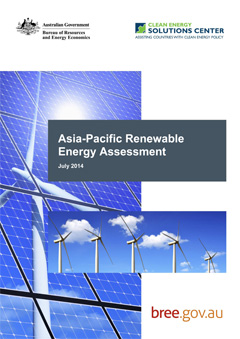7 July 2014
To encourage policies that support delivery of least-cost electricity generation using both fossil fuel and renewable technologies, Australia’s Bureau of Resources and Energy Economics conducted a renewable energy assessment of China, India, Indonesia, Japan, the Republic of Korea and Australia.
The just-released Asia-Pacific Renewable Energy Assessment (APREA) report, which was prepared with input from Clean Energy Solutions Center subject matter experts, describes the current and possible future costs of renewable electricity generation in those six countries. The assessment of levelized costs of electricity generation (LCOE) found that:
- India and China have the lowest generation costs for most renewable energy technologies, followed by South Korea and Australia.
- India has the lowest LCOE for onshore wind, solar PV, biomass and solar thermal electricity.
- Small- and large-scale hydro technologies represent the lowest-cost technologies in most countries; small hydropower technology is cheapest in China, and large hydropower technology is cheapest in South Korea.
- In Australia, electricity generated from onshore wind and biomass resources are the lowest-cost electricity amongst all types of renewable technologies.
- Cost estimates by technology suggest that generation is cheapest for biomass in India, geothermal in Indonesia, onshore wind in India, solar PV in India, solar thermal in India, and offshore wind in China.
China, India, Indonesia, Japan, the Republic of Korea and Australia have all made significant progress with establishing renewable energy policies, measures and investment. These countries also share experience with technical and policy issues related to the integration of renewables into existing electricity networks. These include:
- Technical constraints, load balancing and frequency control issues (on weaker grids) imposed by limitations in existing grid structures and capacities
- Operational difficulties arising from inadequate renewable electricity generation forecasting, market design or management issues, and the availability and coordination of ancillary services
- Institutional challenges such as uncoordinated network planning; a lack of national and technical standards for grid connection of renewable electricity; a policy focus on increasing installed renewable capacity instead of delivered electricity; and a lack of or poorly structured incentives for grid operators to invest in grid reinforcement, interconnection and systems management, and ancillary service provision.
The report concludes that none of these challenges is technically or economically insurmountable; nor are they sufficient to impede the overall growth of renewables in the six countries studied.
Using both country-specific estimates of LCOE and information on policy and technical issues associated with integrating technologies into existing energy networks, APREA determined the following:
- While the level of installed renewable generation capacity has been increasing across all six APREA countries over the past decade, investment in new capacity has typically not been accompanied by the corresponding development of the infrastructure, institutions or market incentives necessary to support efficient integration into national power systems.
- Experiences in integrating renewable energy vary across APREA countries. Those with larger levels of renewable energy penetration (Australia and China) have observed a variety of challenges such as those listed above, while countries with relatively low levels of deployment (Indonesia) have yet to experience any serious difficulties.
- Impacts on the grid are more pronounced where renewable energy deployment is locally or regionally concentrated.
The assessment also revealed the need to create renewable electricity generation targets, in place of any existing capacity expansion targets. Finally, while broad integration issues have been identified, the report found that integration cost estimates are not available in current literature for any of the APREA target countries, including Australia. This represents a significant informational deficit for accessing the relative costs of energy technologies and thus highlights the need for detailed studies aimed at developing renewable energy integration cost estimates.
To learn more or access the complete report, please visit the Asia-Pacific Renewable Energy Assessment report page.

